Start checking your competitor’s keywords straight away with Semrush, our favorite tool for keyword research thanks to its great range of features and powerful analytics. Plus, right now, Semrush is offering Quick Sprout readers a free 7-day trial to try it for themselves.
Understanding which keywords are performing in your industry is important for getting more clicks and conversions. And, a big part of knowing which keywords are working is to see what your competitors are doing.
Luckily, there are now plenty of great tools that can help you assess which keywords your competitors are using, and which ones are, and are not, working for them. That way, you can better understand what your audience is looking for and save yourself time by only using keywords that get you results. In this article, we’ll break down how you can check your competitor’s keywords and the best tools out there to help you.

The Top 5 Best Keyword Research Tools for Checking Competitor Keywords
We’ve rigorously vetted the best tools out there right now for analyzing SEO and checking competitor keywords. Here are our top recommendations based on our research that’ll make it easier for you to see what your competitors are doing and whether it’s working:
- Semrush – Best for Competitor Analysis
- Ahrefs – Best for SERP Analysis
- WriterZen – Best Keyword Tool for Content Marketing
- SEO PowerSuite – Best for Local Keyword Research
- Mangools – Best for Generating Keyword Ideas
Check Competitor Keywords in 5 Easy Steps
It might seem like analyzing what your competitors are doing would be complicated, but, especially with the help of tools like Semrush, it’s surprisingly simple. Let’s walk through the steps you’ll need to take to see what your competition is doing:
- Sign Up For Semrush
- Make a List of Your Competitors
- Look at Their Domain Overview
- Use the Keyword Gap Tool
- Analyze the Data
We’re using Semrush for the purposes of this tutorial because they have a huge range of keyword features, they’re always up to date with the latest data, and they have a user-friendly dashboard. However, you can use another one of the tools we’ve recommended with similar steps and still see great results.
Step 1: Sign Up For Semrush
The first thing you’ll want to do is sign up for Semrush.
Although there are ways you can do some competitor keyword research on your own, it’s easier and faster to use a tool like Semrush.
Once you head over to the homepage through our link and scroll down to the bottom, you’ll be able to sign up for your 7-day free trial.

Click on the link and create an account using your email and password. You’ll be asked for some payment information to sign up for the trial, but you’ll only be charged if you decide to stay past seven days. You’ll then get access to your dashboard.
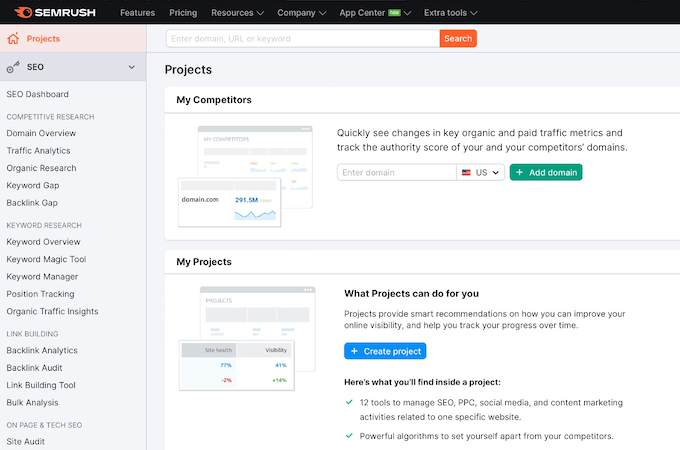
You can see right away that one of the first features Semrush offers is to look at your competitors’ SEO using the projects tool. And, if you look at your dashboard, you can see that there are lots of tools under the Competitive Research tab to help you analyze your competitors.
We’ll be diving into those tools in a second, but once you’ve set up your account, move on to Step 2.
Step 2: Make a List of Your Competitors
Once you’ve created your Semrush account, it’s time to make a list of all your competitors.
Not only will you need to know who your competitors are to be able to see which keywords they’re using – you’ll need to know the URLs of their websites, and even of the specific pages on their sites that you’re hoping to rank against.
This is an easy step, but it can be a little time-consuming.
What you’ll need to do is make a list, preferably an updatable document like a spreadsheet, that includes the names of all the competitors you want to analyze. Then you want to add the URLs of their sites next to each name, and any specific pages you want to see keywords for.
If you’re not sure who your competitors are, it can be as easy as typing in your specific niche on Google and taking down the names of the first few businesses that show up in search results.
You can also use Semrush’s competitor tools by going into your dashboard, adding your domain, and then selecting competitors. This will give you a view of some of your top competitors and you can then use this to add to your list.
It’s better if you can find local competitors or similar-sized businesses. The bigger the business the easier it’ll rank on Google, and you don’t want to end up trying to compete for keywords with companies that are above your domain authority.
Once you have a list of at least 5 competitors to look at, you can move on to Step 3.
Step 3: Look at Their Domain Overview
The next step is to get an overview of which keywords are working for your competitors.
If you go to your dashboard menu to the left side, click on SEO. Under the list of options for Competitive Research, you’ll see an option for Domain Overview. Click on it.
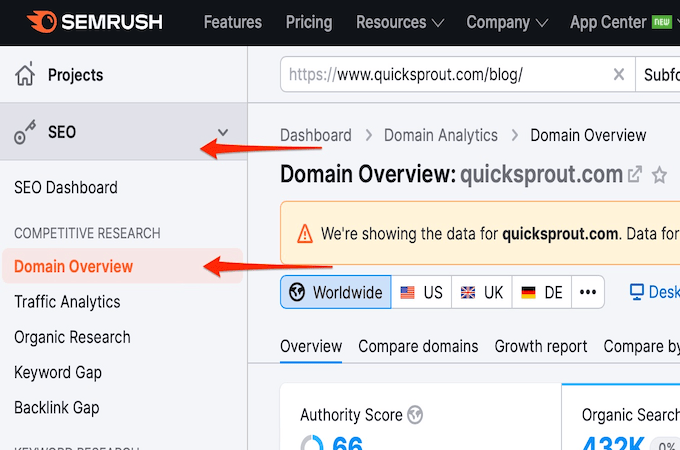
You can then add a domain from one of your competitors in the search bar. This will bring up a lot of results including their traffic numbers and backlink information but you can ignore that. If you scroll down a little, you’ll get to what we’re looking for: Top Organic Keywords.
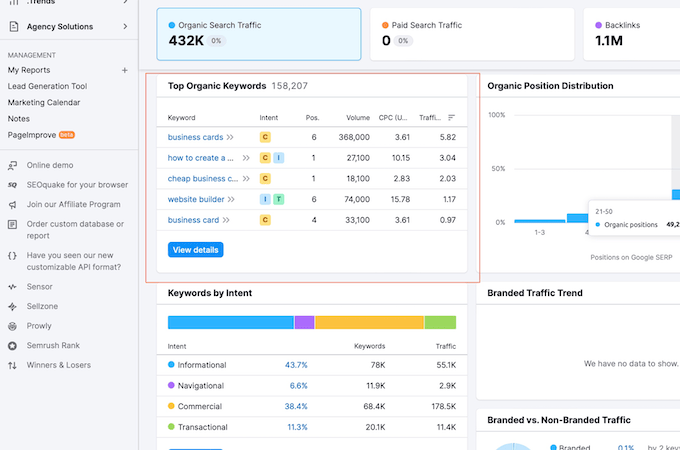
Here, you’ll see which keywords your competitors are ranking highest for without the help of paid advertising. This will help you see what your target audience is interested in, what’s working in your industry, and whether you have a chance of ranking for those words yourself.
If you click on View Details, you can see different metrics like the search volume for each keyword or phrase and the KPI (which will tell you how easy or how hard it is to rank for those words based on your domain authority).
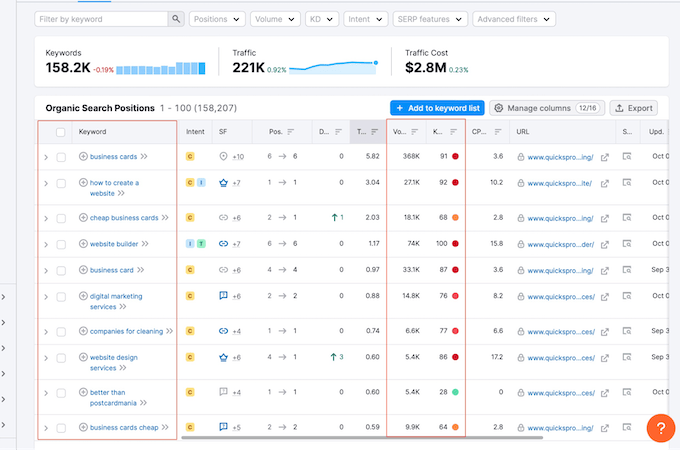
You can see that when we use the Quick Sprout blog as an example, many of the keywords have very high competition, meaning that you’d need a high domain authority to stand a chance of competing.
But, if you are a newer website, you now know which words to avoid because you can’t compete with them. Instead, you could look for similar searches that are longer tail keywords with less competition that can boost your chances of being found by your audience.
Put in the domain for each competitor you have in your spreadsheet, add the top 10 keywords they’re ranking for, and add the search volume and the keyword difficulty to your notes.
Keep in mind that this step works best for the main site domain, and isn’t really for URLs for specific pages. Once you’ve filled out your spreadsheet and added the keywords, you can move on to Step 4.
Step 4: Use the Keyword Gap Tool
If you head back out into your dashboard, you’ll see an option that says Keyword Gap in the Competitive Research menu. Click on it.
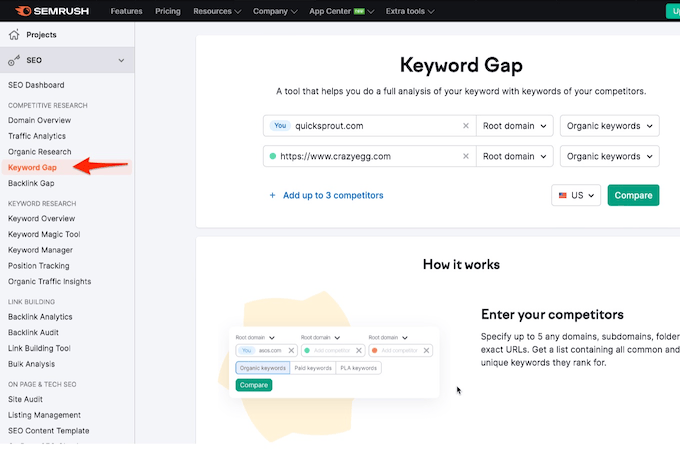
You’ll then be taken to a page where you can add up to five competitors’ domains and compare the keywords between them. The tool will help you see which keywords you share with your competitors, and also which keywords they’re ranking for that you aren’t.
Especially if you have a similar or even better domain authority than your competitors, this is a great way to identify any keywords that you could easily rank for but are currently missing out on.
You’ll also be able to go through a chart of where each of your competitors ranks for specific keywords, and you’ll get a list of which keywords you are missing and where your rankings are weakest.
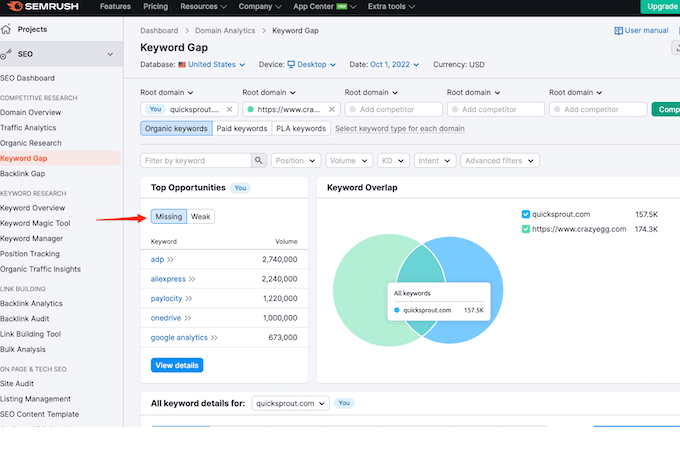
This will then allow you to see where your strategy needs to change and where you should refocus your SEO plan in order to get more traffic.
Again, update your spreadsheet with the words that your competitors are using that you aren’t, and make some notes about which keywords you have that are weak and where you want to change your strategy.
You can also download a report of the Keyword Gap results directly in Semrush by clicking on Export. Once you’ve updated your spreadsheet with all your keywords, you can move on to Step 5.
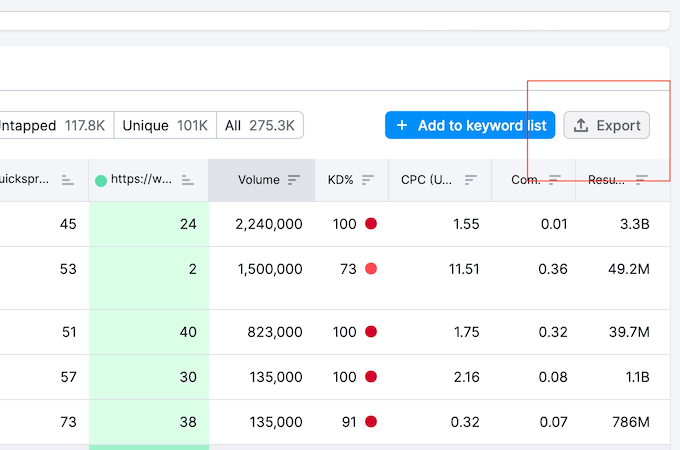
Step 5: Analyze the Data
Once you’ve actually finished going through and recording the keywords your competitors are using, it’s time to put that information into action.
There’s no point doing the research if you don’t use what you’ve learned to help you build a stronger SEO plan. Through your research, you should have been able to identify which keywords your competitors are ranking for that you’re not, which words you have better domain authority for, and which words you are missing.
Using the keywords you’ve found, update your SEO plan by:
- Planning content that uses the keywords you could rank for but aren’t using
- Remove any keywords that Semrush identified as weak and update any existing content with better keywords
- Looking for other keywords closely related to the ones your competitors are ranking highest for
- Plan content around the topics that are getting your competitors the most traffic
The more you improve your keyword use, the better your overall domain authority and SEO will be, and the easier it will be for you to compete with your competitors as time goes on.
You can repeat the process as many times as you like with as many competitors as you want, and you can also use the above steps as a way to generate content ideas to help you get traffic.
Final Thoughts About Checking Competitor Keywords
If you follow the above steps often, you can drastically improve your SEO and you’ll find it much easier to connect with your audience and drive traffic to your site. You’ll also be able to generate relevant content ideas more easily and potentially even get yourself on the first page of Google Search.
Using a tool like Semrush will also help you with market research, and other ways to optimize your SEO. If you combine this guide with all the other features it offers, you’ll be on your way to ranking on page one of Google in no time.
